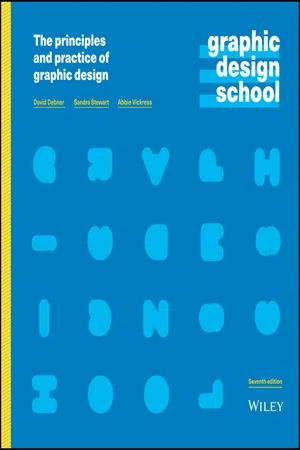
Graphic Design School
The Principles and Practice of Graphic Design
- English
- ePUB (mobile friendly)
- Available on iOS & Android
Graphic Design School
The Principles and Practice of Graphic Design
About this book
From understanding graphic design fundamentals, to developing original concepts, to creating finished designs— Graphic Design School develops design students' core competencies and provides practical advice and tips for how these fundamentals translate into new and evolving media. This Seventh Edition offers all new examples from web, app, social media, magazines, websites and books, presenting a comprehensive overview of the visual communications profession. This updated edition includes guidance and media examples using the latest in grahpic design software, and traditional printing techniques such as risograph and screen printing are revisited. Pedagogical tools throughout the text focus on the growth of interdisciplinary learning and collaborations between design specialists, as well as highlights on key players in the past and present of graphic design.
Topics covered include: color, typographic rules and typefaces, coding requirements, information architecture, file organization, web design and layout, mobile device composition, app design, CMS, designing for social media, and SEO. Graphic Design School, 7th Edition includes full-color illustrations throughout, as well as case studies, designer biographies, and student assignments for testing skills and concepts.
Frequently asked questions
- Essential is ideal for learners and professionals who enjoy exploring a wide range of subjects. Access the Essential Library with 800,000+ trusted titles and best-sellers across business, personal growth, and the humanities. Includes unlimited reading time and Standard Read Aloud voice.
- Complete: Perfect for advanced learners and researchers needing full, unrestricted access. Unlock 1.4M+ books across hundreds of subjects, including academic and specialized titles. The Complete Plan also includes advanced features like Premium Read Aloud and Research Assistant.
Please note we cannot support devices running on iOS 13 and Android 7 or earlier. Learn more about using the app.
Information
PART 1
Principles



1
Research and Concepts
“What you see and hear depends a good deal on where you are standing; it also depends on what kind of a person you are”C. S. Lewis


| PART 1 | PRINCIPLES |
| CHAPTER 1 | RESEARCH AND CONCEPTS |
MODULE 1 BASICS OF RESEARCH
Broaden your outlook
- Read about events from multiple sources. Compare stories, noting how information about the same events changes, how the language is used to target various audiences, and what type of imagery is used to support the text. Never rely solely on editable web pos...
Table of contents
- Cover
- Table of Contents
- Introduction
- PART 1: Principles
- PART 2: Practice
- Glossary
- Bibliography
- Online resources
- Index
- Acknowledgments
- End User License Agreement